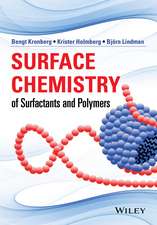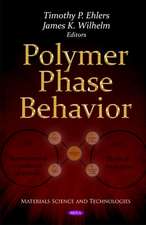Formation and Properties of Clay-Polymer Complexes: Developments in Clay Science, cartea 4
Autor B.K.G. Thengen Limba Engleză Hardback – apr 2012
- Describes the important development in clay-polymer nanocomposites
- Contains new figures and diagrams
- Extenisve revision of the previous edition
Preț: 696.62 lei
Preț vechi: 1126.78 lei
-38% Nou
Puncte Express: 1045
Preț estimativ în valută:
133.29€ • 139.55$ • 110.30£
133.29€ • 139.55$ • 110.30£
Carte tipărită la comandă
Livrare economică 31 martie-14 aprilie
Preluare comenzi: 021 569.72.76
Specificații
ISBN-13: 9780444533548
ISBN-10: 0444533540
Pagini: 526
Dimensiuni: 152 x 229 x 25 mm
Greutate: 0.95 kg
Ediția:2nd revised edition.
Editura: ELSEVIER SCIENCE
Seria Developments in Clay Science
ISBN-10: 0444533540
Pagini: 526
Dimensiuni: 152 x 229 x 25 mm
Greutate: 0.95 kg
Ediția:2nd revised edition.
Editura: ELSEVIER SCIENCE
Seria Developments in Clay Science
Public țintă
clay mineralogists, materials engineers, polymer chemists, university teacher and graduate students in chemical, colloid, materials and soil sciences.Cuprins
Part I: Clay Minerals and Polymer Adsorption1. The clay minerals2. Polymer behaviour at clay and solid surfaces
Part II: Interactions of Clay Minerals with Synthetic Polymers3. Uncharged (non-Ionic) polymers4. Negatively charged polymers (polyanions)5. Positively charged polymers (polycations)6. Some practical applications of the clay-polymer interaction7. Polymer-clay nanocomposites
Part III: Interactions of Clay Minerals with Naturally Occurring Polymers8. Proteins and enzymes9. Nucleic acids10. Viruses and bacteriophages11. Polysaccharides12. Humic substances
Part II: Interactions of Clay Minerals with Synthetic Polymers3. Uncharged (non-Ionic) polymers4. Negatively charged polymers (polyanions)5. Positively charged polymers (polycations)6. Some practical applications of the clay-polymer interaction7. Polymer-clay nanocomposites
Part III: Interactions of Clay Minerals with Naturally Occurring Polymers8. Proteins and enzymes9. Nucleic acids10. Viruses and bacteriophages11. Polysaccharides12. Humic substances
Recenzii
" Theng has made a remarkable effort to combine a voluminous source of information that exists on the interaction of clays with organic polymers and should be congratulated for this effort. The book was long awaited and indeed will be an important reference like the first edition…The overall result is definitely positive and the book should be in the shelf of any mineralogist, soil scientist, chemist and biologist who is interested in these interactions." --Clay Minerals, 2014
"Theng reviews and synthesizes the literature on clay minerals and polymer adsorption, and interactions of clay minerals with synthetic and naturally occurring polymers. His topics include polymer behavior at clay and solid surfaces, uncharged (nonionic) polymers, positively charged polymers (polycations), some practical application of the clay-polymer interaction, polymer-clay nanocomposites, proteins and enzymes, viruses and bacteriophages, and humic substances. He has updated the 1979 first edition to incorporate the substantial developments in clay science that partly result from the application of modern surface analytical, computational, and spectroscopic techniques. He has also added many new illustrations and tabulated data." --Reference and Research Book News, October 2012
"Theng reviews and synthesizes the literature on clay minerals and polymer adsorption, and interactions of clay minerals with synthetic and naturally occurring polymers. His topics include polymer behavior at clay and solid surfaces, uncharged (nonionic) polymers, positively charged polymers (polycations), some practical application of the clay-polymer interaction, polymer-clay nanocomposites, proteins and enzymes, viruses and bacteriophages, and humic substances. He has updated the 1979 first edition to incorporate the substantial developments in clay science that partly result from the application of modern surface analytical, computational, and spectroscopic techniques. He has also added many new illustrations and tabulated data." --Reference and Research Book News, October 2012

















